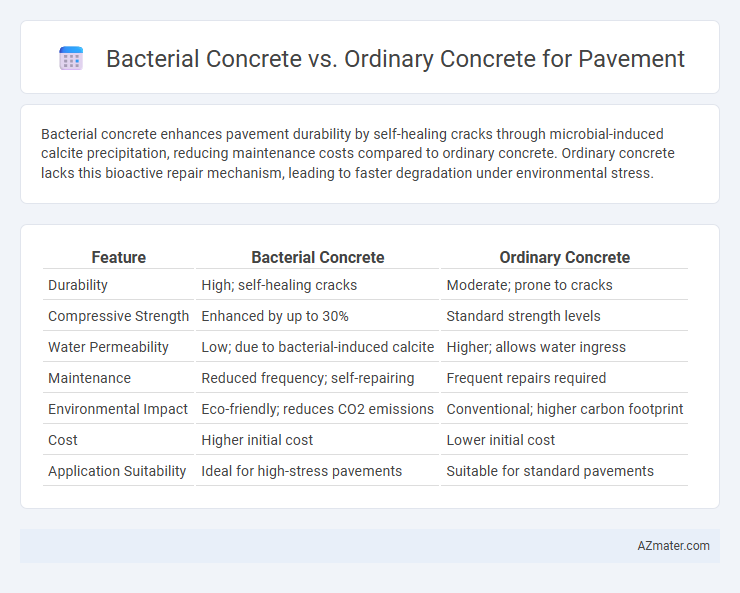Bacterial concrete enhances pavement durability by self-healing cracks through microbial-induced calcite precipitation, reducing maintenance costs compared to ordinary concrete. Ordinary concrete lacks this bioactive repair mechanism, leading to faster degradation under environmental stress.
Table of Comparison
| Feature | Bacterial Concrete | Ordinary Concrete |
|---|---|---|
| Durability | High; self-healing cracks | Moderate; prone to cracks |
| Compressive Strength | Enhanced by up to 30% | Standard strength levels |
| Water Permeability | Low; due to bacterial-induced calcite | Higher; allows water ingress |
| Maintenance | Reduced frequency; self-repairing | Frequent repairs required |
| Environmental Impact | Eco-friendly; reduces CO2 emissions | Conventional; higher carbon footprint |
| Cost | Higher initial cost | Lower initial cost |
| Application Suitability | Ideal for high-stress pavements | Suitable for standard pavements |
Introduction to Bacterial Concrete and Ordinary Concrete
Bacterial concrete incorporates specific strains of bacteria like *Bacillus pasteurii* that induce calcite precipitation, enhancing self-healing properties and durability in pavement applications, contrasting with ordinary concrete which relies solely on traditional cementitious materials. Ordinary concrete, composed primarily of cement, aggregates, and water, often suffers from microcracks and requires regular maintenance due to its limited self-repair capabilities. The integration of microbial-induced calcite precipitation in bacterial concrete offers a sustainable solution by reducing permeability and extending pavement service life compared to conventional concrete formulations.
Composition and Materials Used
Bacterial concrete incorporates specific strains of bacteria, such as Bacillus subtilis, along with a nutrient source like calcium lactate to induce calcite precipitation, enhancing self-healing properties and durability. Ordinary concrete primarily consists of cement, aggregates (sand and gravel), and water, relying solely on these materials for strength and stability without biological components. The integration of bacteria and bio-minerals in bacterial concrete significantly improves crack resistance and extends pavement lifespan compared to traditional mixes.
Mechanism of Strength Development
Bacterial concrete enhances strength development through microbial-induced calcium carbonate precipitation, which fills micro-cracks and pores, resulting in improved density and durability compared to ordinary concrete. This bio-mineralization process accelerates the healing of micro-damages, leading to higher compressive and tensile strength in pavements. Ordinary concrete relies solely on hydration products of cement for strength, making it more susceptible to cracking and permeability over time.
Durability and Longevity
Bacterial concrete significantly enhances the durability and longevity of pavements by promoting self-healing through microbial-induced calcium carbonate precipitation, which seals cracks and reduces permeability. Ordinary concrete lacks this self-repair mechanism, making it more susceptible to water ingress, freeze-thaw cycles, and chemical attacks that accelerate deterioration. Studies show bacterial concrete pavements can last 30-50% longer than ordinary concrete, reducing maintenance costs and extending service life in harsh environmental conditions.
Crack Healing Capabilities
Bacterial concrete incorporates specific strains like *Bacillus pasteurii* that precipitate calcite to seal micro-cracks autonomously, significantly enhancing crack healing capabilities compared to ordinary concrete. This self-healing mechanism reduces maintenance costs and extends pavement lifespan by preventing water ingress and subsequent deterioration. Ordinary concrete lacks this biological repair function, often requiring manual intervention to address cracking and structural degradation.
Environmental Impact
Bacterial concrete significantly reduces environmental impact compared to ordinary concrete by enhancing self-healing properties, which extends pavement lifespan and decreases the frequency of repairs, thereby lowering resource consumption and waste generation. The use of calcite-producing bacteria in bacterial concrete promotes carbon sequestration, effectively reducing CO2 emissions associated with traditional cement production. Furthermore, bacterial concrete exhibits improved durability and resistance to cracking, minimizing the need for new materials and mitigating the environmental footprint of pavement infrastructure maintenance.
Cost Comparison
Bacterial concrete reduces long-term maintenance costs for pavement due to its ability to self-heal cracks, significantly extending service life compared to ordinary concrete. Initial construction costs are higher for bacterial concrete, often ranging 10-20% above ordinary concrete, driven by the expense of bacterial additives and specialized mixing processes. Over time, the reduced need for repair and replacement can result in overall cost savings, making bacterial concrete a cost-effective solution for durable pavements.
Application Techniques for Pavement
Bacterial concrete for pavement utilizes bio-mediated self-healing properties where specific bacteria such as Bacillus pasteurii precipitate calcium carbonate to seal cracks, enhancing durability and reducing maintenance. Application techniques include embedding bacterial spores and nutrients within the concrete mix or spraying bacterial solutions onto pavements post-curing to activate crack repair processes. Ordinary concrete relies on traditional mixing, casting, and curing methods without bioactive components, requiring frequent repairs and higher lifecycle costs compared to bacterial concrete in pavement applications.
Performance in Harsh Conditions
Bacterial concrete demonstrates superior durability and crack resistance in harsh environmental conditions compared to ordinary concrete, due to the self-healing properties enabled by microbial calcite precipitation. This bio-concrete significantly reduces permeability and enhances resistance to freeze-thaw cycles, chemical attacks, and abrasion, which are common challenges in pavement applications. Consequently, bacterial concrete extends the service life of pavements in extreme climates, reducing maintenance costs and improving long-term performance.
Future Prospects in Pavement Construction
Bacterial concrete offers significant future prospects for pavement construction due to its self-healing properties and enhanced durability, which reduce maintenance costs and extend pavement lifespan. The integration of calcite-producing bacteria can improve crack resistance and environmental sustainability by lowering carbon footprints compared to ordinary concrete. Advancements in biotechnology and material science are driving the potential widespread adoption of bacterial concrete as a smart, resilient solution for sustainable infrastructure development.

Infographic: Bacterial concrete vs Ordinary concrete for Pavement
 azmater.com
azmater.com